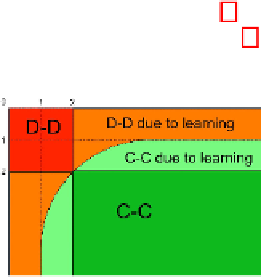Information Technology Reference
In-Depth Information
Rawls' Ideality
Analogously, we now use Rawls' algorithm of ideality the agent's
U
∗
, keeping all the
experiment parameters at their default values. Figure 2 shows a schematic representa-
tion of the results, organized similarly to previous figure 1.
Fig. 2.
Rawl's ideality results
Unsimilarly to the results obtained with Harsanyi's ideality, we observe that in this
case guilt aversion plays an important role in the emergence of fairness as a moral
value. Indeed, agents with a higher degree of risk aversion have a higher average payoff
than those who do not present guilt aversion (that is, those who do not experience guilt
feelings triggered by the transgression of the fairness value).
In addition, in Rawls' case we have some nuances that we did not have in Harsanyi's
case. In particular, the strategy chosen by the agents not only depends on their degree
of guilt aversion, but also on the number of interactions they have been part of. This
highlights the influence of the learning curve on the decision-making process.
4
Conclusions and Future Work
Hence we can finish by concluding that, from an evolutionary point of view, it is the
moral values
àla
Rawls that emerge and that guilt aversion does play an important role
in the suitability over time of fairness. As R. Frank stated, “[t]he fact that it might some-
times be best to ignore moral emotions does not imply that it is always, or even usually,
best to ignore them. If we are to think clearly about the role of moral emotions in moral
choice, we must consider the problems that these emotions were molded by natural se-
lection to solve. Most interesting moral questions concern actions the individual would
prefer to take except for the possibility of causing undue harm to others. Unbridled pur-
suit of self-interest often results in worse outcomes for everyone. In such situations, an
effective moral system curbs self-interest for the common good. [Furthermore,] moral
systems must not only identify which action is right, they must also provide motives for
taking that action.” [13, pp. 7-8]
This article presents an on-going piece of research that is much to be completed. Al-
though many, we shall note here some of the possible research questions to investigate
further. Firstly, we would like to test the model with different population distributions
(according to their degree of guilt aversion), in order to explore which is the minimum

